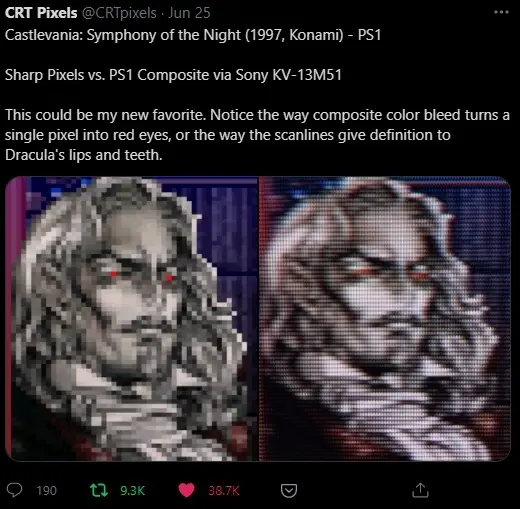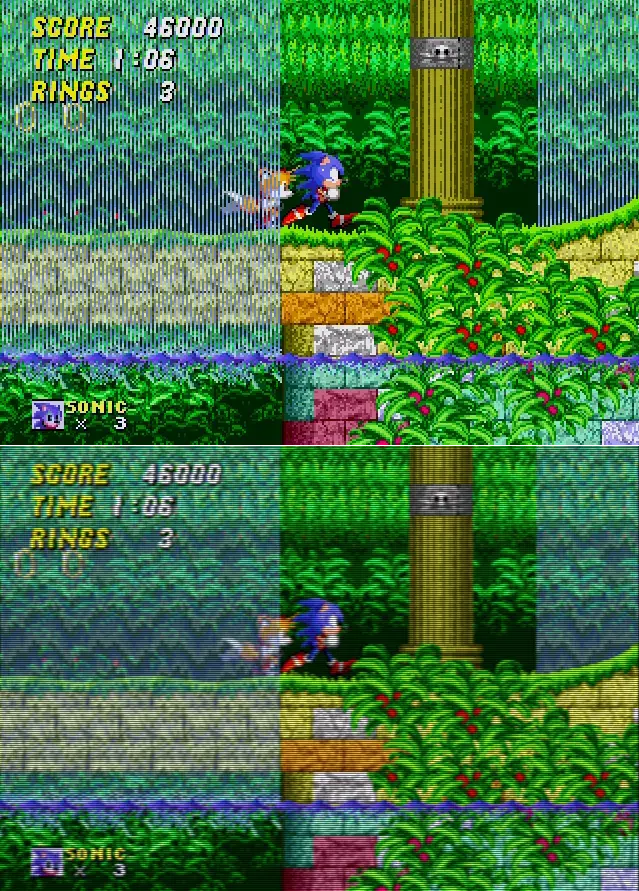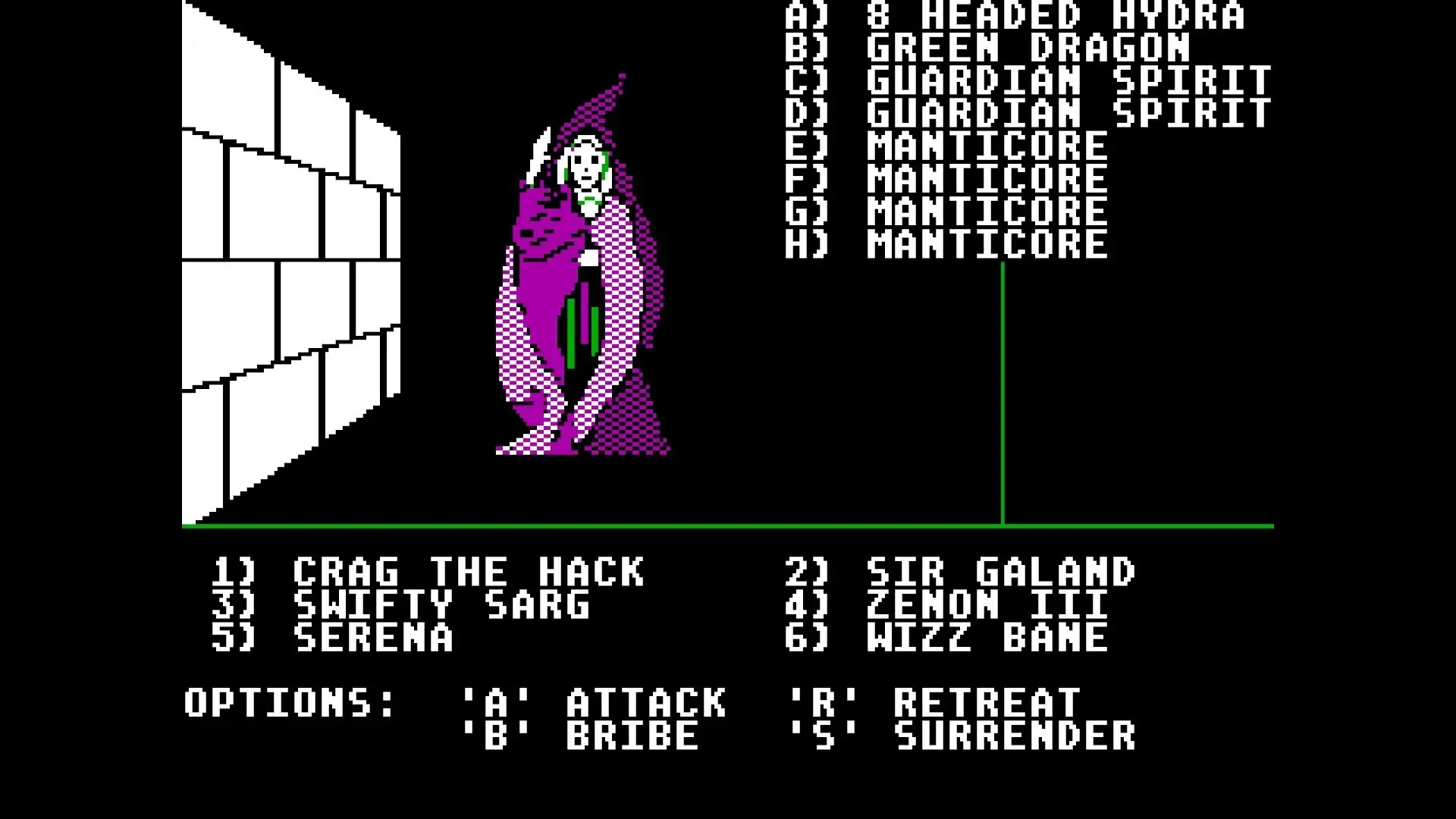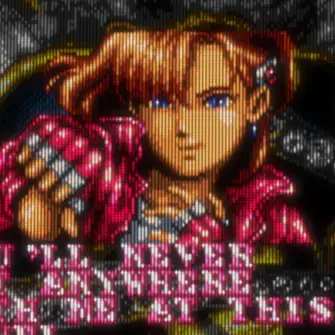No, I don’t need it.
I strongly disagree with the premise that there’s a “wrong” way to play retro games. Don’t gatekeep. Imagine if people told you not to listen to Pink Floyd unless it’s on vinyl. It would be lost media.
That said, CRTs present images fundamentally differently than LCD displays, and a lot of developers took advantage of those idiosyncrasies. There are scanlines everywhere. CRT phosphors aren’t square, and appear smaller when darker. Bright pixels can “bleed” into nearby pixels, particularly when using composite signals.
Before LCDs, many (not all) pixel artists used this to their advantage, basically harnessing the imperfections of analog TV to provide equivalents to anti-aliasing, bloom, extra color depth, and even transparency. Some particularly famous examples came from Sega Genesis games. This video goes into good depth on the whys and hows, and there are some solid examples of the outcomes here.
I’ve attached examples below (hopefully they upload). If you like the raw pixel art, then no harm done. Enjoy! But if you like the way CRTs interpreted and filtered those signals, you owe it to yourself to look up some shaders for your favorite emulator.


(Zero Tolerance, 1994, on the Genesis/Mega Drive)

(Sonic the Hedgehog 2, 1992, on the Genesis/Mega Drive)
I strongly disagree with the premise that there’s a “wrong” way to play retro games.
I understand your sentiment here and you are right too. What I think is, that the wording on this title here is misunderstood. Emulating (old) games without Shaders is not faithful or accurate in the looks. It looks “vastly” different and thus means it looks “wrong”. I interpret the “wrong” in the title as “not faithful”, instead as “bad”, like this: You’re Probably Emulating Retro Games Not Faithful (you need CRT Shaders for the oldschool look)
The benefit of CRTs is most apparent in pre-rendered backgrounds (See Final Fantasy, Resident Evil). These backgrounds look incredible with shaders, and, indeed, on real displays.
Good looks stay good.
My aim was never to emulate but to play. Blur filters are something that I won’t be using.
You’ll never catch me using filters like these voluntarily. Inject those crisp pixels straight into my vein.
I was a crisp pixel diehard for like 20 years even despite growing up with CRT, because I remember in the 80s-00s trying hard to get the clearest picture (RF->SRGB->S-video->Composite) and it felt like, “what’s clearer than exact pixels?”
And then I tried a good CRT filter that emulates not just scanlines and noise, but subpixel effects, and it really changed my mind. The graphics really were designed to be displayed with those analog “imperfections,” and if you lived in that era, you kind of took for granted the things that worked well with the natural CRT blur while pursuing image clarity. Bringing back the CRT effects was a revelation.
Like, even handheld emulation filters that mimic how those particular LCD screens functioned often give a better experience since game designers took that into account.
I don’t know if someone growing up with only emulated square LCD memories would feel the same, and I’ll always take pixely LCD over bad CRT emulation, but I’d suggest to give it a try with good filters.
Honestly, I hate the CRT aesthetic. I grew up with CRTs. Leaving them behind for LCDs was one of the greatest transitions of growing up. By all means, enjoy them if you do, but I don’t.
It’s not just the look of it, but the art and games were designed with the limitations of CRT in mind. Not all games off course. An example is the transparency effect on Genesis / Mega Drive:


Getting the settings right for video is critically important, too. Scaling needs to be done with the nearest neighbor pixel method, not more modern blend methods.
Shaders are not only useful for CRT emulation, but also to get the look of handhelds:

Ah jeez, this picture triggered the earworm! Now that song is in my head!
Add that China theme to the mix.
You’re welcome.
Fucking Moai 🗿 heads
Does this shader also replicate the horrific motion blur that the display of the original GameBoy suffered from?
There are two variants, one with motion-blur and one without. Besides that, often shaders have additional settings. One can change settings and save it as a new Shader Preset and use that instead. I have described it here: https://thingsiplay.game.blog/2024/10/19/showcase-for-retroarch-shaders-2024/8/#learn-and-explore
Thanks. I shall avoid the motion blur variant as best as I can, because that’s one of several aspects of this device I do not remember fondly.
I borrowed a friend’s Game Boy for an afternoon when I was a kid and I was so disappointed by it (primarily the screen, but also poor ergonomics and the limited nature of its games) that I lost nearly all interest in gaming for a year.
Yes, you’re all doing it wrong…by doing it at all.
Original hardware, especially CRTs, is increasingly difficult to find and getting more expensive and less reliable by the day (both of my N64 are completely dead right now - just from sitting unused in a dry cupboard for a few years).
Love it or hate it, this is the future of retro gaming.
Okay.
No and no. Clickbait bullshit.
Clickbait would not include in the title that the secret is CRT shaders.
It’s not telling me a secret, it’s telling me that I’m doing something wrong and that I need to use CRT shaders, which are both wrong presumptions made to make me click on the video to find out why. Whether to use a CRT filter or other things like scanlines is completely subjective and up to a users preferences. There’s nothing wrong with sharp pixels over blurry pixels.
“You’re emulating retro games wrong” is not the best title. For example, Dosbox Staging enabled the CRT filter by default at some point; there is no graphical interface, you need to open a file and change a line to revert it. Moreover, there was no indication that the black lines were not a bug but were a filter.
Playing DOS games on operating systems which do not support DOS programs natively is still emulation. However, the number of DOS games which utilised CRT effects are much fewer such that I primarily played DOS games in 2022–23 and none of them made use of CRT. However, the black lines were enabled till I figured it out (because there were no support requests surprisingly, and the default filter being changed was mentioned in an unrelated request regarding bad performance issues—where it was made known and the recommendation was made to change the setting).
The (slight) problem is with the title itself. It is not a big issue for me, but the statement made in the title is the problem because it is only in a comment that it was mentioned not all old games use CRT effects. Clickbait might not be the best word for describing the situation, but the title will be annoying for many who play old games which were not designed for CRT effects. But then, it is not a big problem and I more or less ignored it (to be clear, for being wrong as far as the title itself goes) before seeing this thread. It would’ve been better to state directly instead that many old console games and games of the adventure genre, among others, were designed with these filters in mind and for practical reasons (like actually having the graphics show what they were meant to show) because like in your other comment that specific scene does not show the background at all without the effect, and it will be a fairly common occurrence for games which were designed to use the CRT effect.
Edit: spelling
Up to a certain point in the early to mid 2000s, virtually all home console and PC games were designed for CRT displays. I’m not sure where you’re getting the idea from that the type of display that was used by 99% of gamers on these systems was somehow not influencing the art design and technology of games.
Might and Magic Book One does not. Heroes of Might and Magic 2 does not. Carmageddon does not. Elder Scrolls Arena does not.
I played them. With the filter. That’s where I got the idea from.
Edit: These are pre-2000’s games, sure. It isn’t big enough of a problem for me anyway, I can ignore the title.
With the filter
Which one? There a dozens commonly used ones. All of these games are from the CRT era and were developed on and for CRT monitors.
Might and Magic Book One
Notice the dithering pattern on the characters in this screenshot:
This was only done for CRTs, since it results in blended pixels.
Heroes of Might and Magic 2
More CRT dithering everywhere, just two generations later and with more colors and fine detail - but it’s still the same technique:
Carmageddon
https://www.mobygames.com/game/367/carmageddon/screenshots/dos/887670/
Notice the color banding on the textures? CRTs blend that together, resulting in a much smoother look even with software rendering.
Elder Scrolls Arena
https://www.mobygames.com/game/803/the-elder-scrolls-arena/screenshots/dos/305893/
Our old friend Mr Dithering makes an appearance once again.
I hope I’ve made my point clear. It’s fine if you prefer the clean pixelated look of LCD displays, but it’s clear that this is not what these games were meant to look like.
I did find something which did use CRT effects. However the Dosbox Staging one is still a bad one. Elder Scrolls Arena.
With.

Without.

I will make the edit clarifying the mistake.
However it does not change that the others do not use the effects (there is no indication the pixels in might and magic book one were for the CRT effects, unlike here. The pixels in Might and Magic Book One are also too sharp), and the problem has always, and solely, been the title of the post and nothing more.
And as I stated it is not too much of a problem for me, already. Not something I cannot ignore.


No-CRT filter screenshots that I have available. I do not have screenshots for the CRT filter. I suppose I could boot up and try to put the filter for this one; I have Heroes 2 installed too but it is currently a pre-configuration I do not want to mess with in case I possibly mess it up. It feels like a pain to do so though as I’m already occupied for the day, and would like my PC time to, you know, play. Since this is unrelated to help requests, in which case I may have made time for it (I’d usually do it in the past, but not for a while).
Edit: Changed No CRT to No-CRT for clarity
Which one? There a dozens commonly used ones
Dosbox Staging has one CRT filter which is the one I’ve used. The town wall graphics (edit: In might and magic book one) get completely messed up with it. It is possible the bad effects for each of the 4 games mentioned was caused by a bad CRT filter.
That said it would’ve been better to include screenshots which do use the CRT filter. I have played all 4 of these games with and with Dosbox Staging’s CRT filter and they all have had black lines obscuring the screen. Not having it enabled, on the other hand, the games looked like these screenshots.
If there was a good crt shader I’d love to use it. Haven’t seen any good ones yet.
Now I’m curious what your criteria are. Do none of the shaders shown in the video appeal to you? To me at least, they look remarkably close to several types of old CRT TVs that I remember.
I only know of filters in emulators I’ve used for nes, super nes, Genesis, gb advance, dolphan, duckstation, and whatever other emulators over the years.
None of them have had a crt shader that’s good.
I’m currently toying around with ares (the only fully cycle-accurate SNES emulator) and it has a lovely selection of CRT shaders (that are also available for other emulators). Try out crt-maximus-royale (or the half-res-mode variant). At least to me, the latter looks perfect, with just the right amount of blur, distortion, bloom and scanlines - and it comes with lovely details, like the bezel reflecting the image in real time and speaker grills filling the rest of the screen.
Someone uploaded a gallery with various games to reddit that shows just how versatile this shader is:
https://old.reddit.com/r/RetroArch/comments/1ag834e/while_mega_bezels_is_great_and_all_i_think_the/
Will do, thank you for the suggestion!
Happy to help. If you don’t like this shader, but end up preferring a different one, I’d love to hear about it.
Real. Ever since I spent some time setting up good CRT shaders, playing retro games feels a lot cooler. They just give the best feeling and look pretty nice with them on. Sometimes for fun, I leave the shader on for regular Windows usage.










